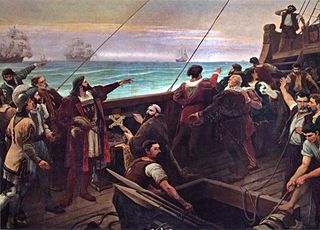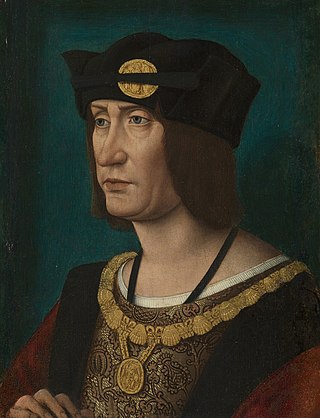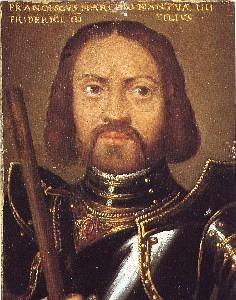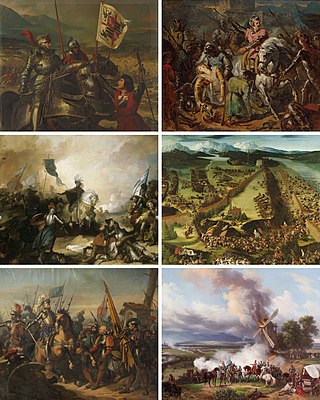Contents
| |||||
| Decades: | |||||
|---|---|---|---|---|---|
| See also: | Other events of 1500 History of France • Timeline • Years | ||||
Events from the year 1500 in France
| |||||
| Decades: | |||||
|---|---|---|---|---|---|
| See also: | Other events of 1500 History of France • Timeline • Years | ||||
Events from the year 1500 in France

Francesco I Sforza was an Italian condottiero who founded the Sforza dynasty in the duchy of Milan, ruling as its (fourth) duke from 1450 until his death.

Year 1500 (MD) was a leap year starting on Wednesday in the Julian calendar. The year 1500 was not a leap year in the proleptic Gregorian calendar.

Louis XII, also known as Louis of Orléans, was King of France from 1498 to 1515 and King of Naples from 1501 to 1504. The son of Charles, Duke of Orléans, and Marie of Cleves, he succeeded his second cousin once removed and brother-in-law, Charles VIII, who died childless in 1498.

Francesco II Gonzaga was the ruler of the Italian city of Mantua from 1484 until his death.

The Italian Wars were a series of conflicts fought between 1494 and 1559, mostly in the Italian Peninsula, but later expanding into Flanders, the Rhineland and Mediterranean Sea. The primary belligerents were the Valois kings of France, on one side, and their opponents in the Holy Roman Empire and Spain on the other. At different points, various Italian states participated in the war, some on both sides, with limited involvement from England, Switzerland, and the Ottoman Empire.

Ludovico Maria Sforza, also known as Ludovico il Moro, and called the "arbiter of Italy" by historian Francesco Guicciardini, was an Italian nobleman who ruled as the Duke of Milan from 1494 to 1499.

The Duchy of Milan was a state in Northern Italy, created in 1395 by Gian Galeazzo Visconti, then the lord of Milan, and a member of the important Visconti family, which had been ruling the city since 1277.

The Duchy of Mantua was a duchy in Lombardy, northern Italy. Its first duke was Federico II Gonzaga, member of the House of Gonzaga that ruled Mantua since 1328. The following year, the duchy also acquired the March of Montferrat, thanks to the marriage between Gonzaga and Margaret Paleologa, Marchioness of Montferrat.

Gian Giacomo Trivulzio was an Italian aristocrat and condottiero who held several military commands during the Italian Wars.

The First Italian War, or Charles VIII's Italian War, was the opening phase of the Italian Wars. The war pitted Charles VIII of France, who had initial Milanese aid, against the Holy Roman Empire, Spain and an alliance of Italian powers led by Pope Alexander VI, known as the League of Venice.

The Italian Wars of 1499–1504 are divided into two connected, but distinct phases: the Second Italian War (1499–1501), sometimes known as Louis XII's Italian War, and the Third Italian War (1502–1504) or War over Naples. The first phase was fought for control of the Duchy of Milan by an alliance of Louis XII of France and the Republic of Venice against Ludovico Sforza, the second between Louis and Ferdinand II of Aragon for possession of the Kingdom of Naples.

Ascanio Maria Sforza Visconti was an Italian cardinal of the Catholic Church. Generally known as a skilled diplomat who played a major role in the election of Rodrigo Borgia as Pope Alexander VI, Sforza served as Vice-Chancellor of the Holy Roman Church from 1492 until 1505.

The Battle of Novara was fought on 8 April 1500 between the forces of King Louis XII of France and the forces of Ludovico Sforza, the Duke of Milan.
Louis Gonzaga may refer to:
Louis Gonzaga, nicknamed "Rodomonte" due to his physical prowess, was an Imperial mercenary captain for Emperor Charles V.

Ludovico Gonzaga was an Italian nobleman and condottiero, a member of the House of Gonzaga branch of Sabbioneta.

The Treaty of Blois (1499), signed on 9 February 1499, was a secret military alliance between Louis XII of France and the Republic of Venice, in which they agreed to a joint attack on the Duchy of Milan. In return, the Venetians were to receive part of the Duchy, while France also undertook to provide military assistance if Venice was attacked by the Ottoman Empire.
The siege of Novara took place in the summer and autumn of 1495 during the Italian War of 1494–1495. While king Charles VIII of France was retreating to the north after facing rebellions in the recently conquered Kingdom of Naples, and managed to escape the destruction of his army at the Battle of Fornovo, his cousin and future king Louis d'Orleans opened a second front by attacking the Duchy of Milan and occupying the city of Novara. In an effort to retrieve it, the Milanese army and their League of Venice allies besieged Novara for three months and fourteen days. Suffering from severe starvation and disease, the French lost about 2000 soldiers before Louis had to surrender and withdraw.